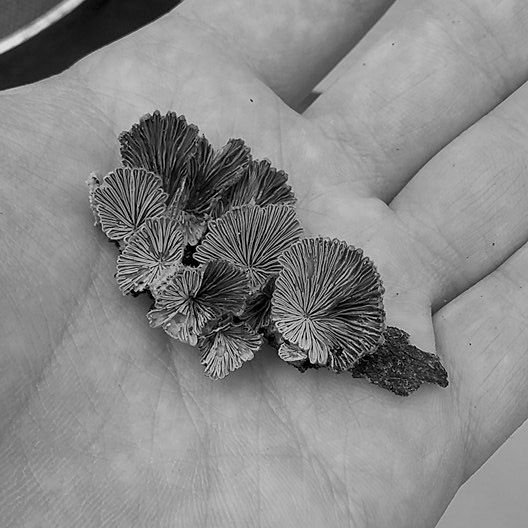This is my second entry for @daveks black and white photo contest.
You can check my first entry about morel mushrooms here.
The theme of this contest is food and for this entry I've chosen to submit a picture of one of my favorite mushrooms, the Split Gill fungus (Schizophyllum commune).

This picture was taken with an iPhone 4S camera.
Although this mushroom is regarded as inedible or unpalatable in most Western mushroom identification guides, it's widely consumed in Mexico, India, and some tropical countries [1].
In the state of Manipur, it's called Kanglayen and it's one of the main ingredients of a mushroom pancake called "Paaknam". In the northeastern Indian state of Mizoram it's called Pasi (meaning tiny mushroom; Pa = mushroom, si = tiny).
In Mexico, it's called xi´i tnu kutu (meaning the mushroom of the copal tree; xi´i = mushroom, tnu (yutnu) = tree; kutu = copal) by the Mixtecs or Ñuu savi, a native group from southeastern Mexico that consumes this fungus as food [2].
S. commune is one of the most widely distributed fungi on the planet (as its species name indicates), being found in all continents except for Antarctica. And according to the Fungal Database published by the U.S. Department of Agriculture, this fungus can grow on 373 different species of trees, which explains why it's so spread.
This mushroom is easily recognized and really beautiful. Its fruiting bodies have no stem and have what look like gills on its underside. However, these are not gills but folds that appear to be split as they dry out and rehydrate many times over the course of a growing season (in fact, Schizophyllum means Split Leaves). This is part of the reproductive strategy of the fungus, since the mushroom can survive periods of dry weather by closing its gills, and reopen them to release its spores during periods of rain.
Other Macroscopic Features (from [4] and [5])
Ecology: Saprophytic, growing on decaying hardwood or parasitic on living trees causing white rot. Found more frequently growing gregariously to clustered. Found year round and widely distributed throughtout the world except for Antarctica.
Fruiting Bodies: 1-5 cm wide, fan-shaped and flat. The upper surface of the mushrooms is covered with small white to grayish hairs.
Odor/Taste: Not distinctive.
Spore Print: White.
Fun/Weird Facts: there's a bunch of documented cases of Schizophyllum commune growing in humans, specially inmunocompromised people, and in one case it was found growing through the soft palate of a child's mouth.
Sources:
[1] Ruán-Soto, F.; Garibay-Orijel, R.; Cifuentes, J. (2006). "Process and dynamics of traditional selling of wild edible mushrooms in tropical Mexico". Journal of Ethnobiology and Ethnomedicine. 2 (1): 3.
[2] Hernández-Santiago, F. et al. (2016). "Traditional knowledge and use of wild mushrooms by Mixtecs or Ñuu savi, the people of the rain, from Southeastern Mexico". Journal of Ethnobiology and Ethnomedicine. 12:35.
[3] Farr, D.F.; Rossman. A.Y.; Fungal Databases, Systematic Mycology and Microbiology Laboratory, ARS, USDA (2006) http://nt.ars-grin.gov
[4] O'Reilly, P., Schizophyllum commune. Retrieved from the First-Nature.Com Web site: http://www.first-nature.com/fungi/schizophyllum-commune.php
[5] Kuo, M. (2003, June). Schizophyllum commune. Retrieved from the MushroomExpert.Com Web site: http://www.mushroomexpert.com/schizophyllum_commune.html
[6] Restrepo, A. et al. (2009)."Ulceration of the palate caused by a Basidiomycete Schizophyllum commune". Sabouraudia: Journal of Medical and Veterinary Mycology. 11(3):201
Minnowsupportproject
Proud member and supporter of the minnowsupportproject - brought to you by @aggroed, @ausbitbank, @teamsteem, and @canadian-coconut
Click the logo below to learn more
)
SteemSTEM
Interested in science, technology, engineering and mathematics? Then, please support @steemstem, a community-supported project aiming to increase the quality and the visibility of well-written, high-quality, STEM-related content. Just click the banner below created by @foundation to join the chat channel.

